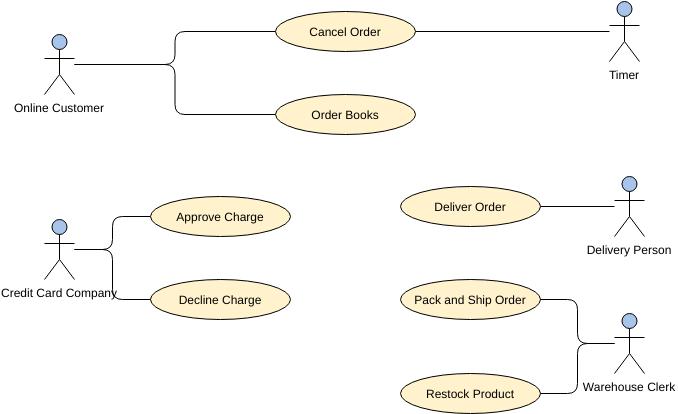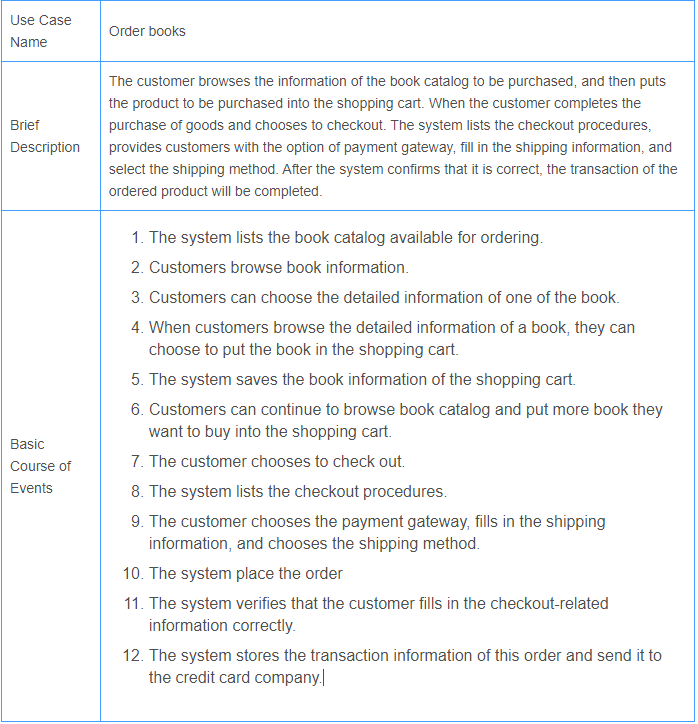Apa itu kasus penggunaan?
Sebuah kasus penggunaan adalah teknik pengambilan dan dokumentasi kebutuhan yang dapat ditulis dalam teks biasa untuk menggambarkan dengan cara naratif tindakan dan interaksi peserta yang menggunakan sistem. Akhirnya, fungsionalitas sistem harus memenuhi tujuan di mana pemangku kepentingan menggunakan sistem.
Sebelum menggunakan teks untuk mendokumentasikan deskripsi kasus penggunaan, kita dapat terlebih dahulu menggunakan diagram kasus penggunaan untuk menyoroti tujuan aktor yang menggunakan sistem. Dengan representasi grafis, Anda dapat dengan cepat memahami keseluruhan gambaran dari sudut pandang burung. Tentukan ruang lingkup sistem (batasan sistem) dan identifikasi tujuan utama aktor (disebut kasus penggunaan) yang mendukung penggunaan fungsionalitas atau layanan sistem.
Diagram kasus penggunaan baik untuk komunikasi tim, dan ini adalah sifat manusia: menggunakan grafik seringkali lebih baik daripada berkomunikasi melalui kata-kata.
Setelah tim memiliki pemahaman awal dan konsensus tentang tampilan dan nuansa keseluruhan sistem, analis kebutuhan membuka oval — kasus penggunaan dan menggambarkan proses dialog antara aktor dan sistem dalam format yang benar dan mudah dibaca.
Secara bertahap tingkatkan ketepatan kasus penggunaan dari yang sederhana hingga yang kompleks. Jangan terjebak dalam detail yang rumit pada awalnya, agar Anda tidak menginvestasikan terlalu banyak semangat dalam desain dan deskripsi yang salah. Diagram kasus penggunaan membantu berpindah dari yang sederhana ke yang kompleks dan mengurangi kesalahan yang tidak perlu.

Seperti yang dapat dilihat dari gambar, ruang lingkup desain sistem ini adalah “sistem pemesanan buku online”, salah satu peserta utama yang menggunakan sistem ini adalah “Pelanggan online”, tujuan peserta yang menggunakan sistem ini adalah “memesan buku”.
“Memesan buku” adalah kasus penggunaan untuk sistem, dan aktornya adalah “pelanggan online.” Setelah menentukan tujuan peserta, kami akan mencatat rincian tujuan dalam narasi teks, yaitu mencatat interaksi antara peserta dan operasi sistem untuk mencapai tujuan. Ini disebut deskripsi kasus penggunaan.
Tabel berikut menggambarkan kasus penggunaan “Memesan buku” yang sederhana.

Asal Usul Kasus Penggunaan
Kasus penggunaan pertama kali diterbitkan oleh raksasa perangkat lunak Jacobson pada tahun 1992, yang memiliki dampak besar pada teknologi berorientasi objek modern. Selain itu, UML (Bahasa Pemodelan Terpadu) spesifikasi yang dirumuskan bersama oleh yang disebut “3 Amigos” — Booch, Jacobson, dan Rumbaugh dan telah ditinjau oleh OMG telah dimasukkan sebagai bagian penting dari spesifikasi standar utama.
Berikut adalah definisi kasus penggunaan oleh beberapa raksasa perangkat lunak.
- “Kasus penggunaan adalah dokumen naratif yang menggambarkan urutan proses seorang aktor yang menggunakan sistem untuk menyelesaikan sebuah peristiwa” [Jacobson92].
- “Kasus penggunaan adalah sekumpulan skenario (alur peristiwa), yang terkait dengan tujuan penggunaan umum dari sistem” [Fowler97].
- “Kasus penggunaan adalah urutan tindakan yang dilakukan oleh seorang aktor (biasanya seorang manusia, tetapi mungkin entitas eksternal, seperti sistem lain) dalam sebuah sistem untuk mencapai tujuan tertentu” [Rosenberg99].
- “Kasus penggunaan adalah seorang aktor (biasanya seorang pengguna, tetapi mungkin entitas eksternal, seperti sistem eksternal lainnya), serangkaian tindakan untuk mencapai tujuan tertentu dalam interaksi dengan sistem internal.”
Dalam buku “Panduan Pengguna Bahasa Pemodelan Terpadu”, definisi Kasus Penggunaan diberikan:
- “Kasus penggunaan menggambarkan sekumpulan urutan, di mana setiap urutan mewakili interaksi antara hal-hal di luar sistem (aktor-aktornya) dengan sistem itu sendiri (dan abstraksi kuncinya)”.
- “Kasus penggunaan menggambarkan serangkaian urutan, masing-masing mengekspresikan interaksi antara hal-hal di luar sistem (peserta) dan sistem itu sendiri (dan abstraksi kuncinya).”
Dari diskusi di atas, kita dapat memperoleh karakteristik yang terkait dengan kasus penggunaan:
- Kasus penggunaan adalah dokumen naratif yang dijelaskan dalam bahasa alami (seperti narasi dalam bahasa Inggris). Secara umum, kasus penggunaan tidak melibatkan grafik atau tata bahasa bahasa pemrograman (seperti java) untuk menggambarkan.
- Skenario yang dijelaskan dalam kasus penggunaan adalah tepat apa yang diharapkan aktor untuk dicapai (mendapatkan) tujuan mereka (Tujuan) dari interaksi dan komunikasi dengan sistem.
- Sebagai contoh, “Membeli Barang” adalah tepat tujuan konsumsi konsumen:
“Para konsumen memeriksa barang yang dibeli, dan kasir mencatat barang yang dibeli dan mengumpulkan pembayaran. Setelah selesai, konsumen pergi dengan barang tersebut.” - Kasus penggunaan dapat memiliki skenario normal dan dengan beberapa skenario pengecualian. Skenario normal menggambarkan proses interaksi normal antara peserta dan sistem; sementara dalam proses interaksi dengan sistem, jika terjadinya pengecualian diperhitungkan, tergantung pada kompleksitas situasi, dapat dijelaskan dalam “jalur alternatif” dalam skenario normal” atau dapat dijelaskan dalam skenario lain untuk pengecualian kompleks.
- Sistem akan menyediakan serangkaian fungsi untuk berinteraksi dengan peserta, tetapi peserta tidak perlu tahu apa yang terjadi di dalam sistem atau bagaimana melakukannya, sistem hanya perlu mengirimkan hasil kembali kepada peserta. Oleh karena itu, bagi peserta, sistem adalah (atau sekelompok kasus penggunaan) sebuah kotak hitam.
- Deskripsi kasus penggunaan menekankan apa yang harus dilakukan sistem (apa yang harus dilakukan), bukan bagaimana melakukannya (bagaimana melakukannya). Oleh karena itu, rincian implementasi tidak boleh dijelaskan dalam deskripsi kasus penggunaan.
- Aktor langsung datang ke sistem operasi. Dalam diagram kasus penggunaan, meskipun aktor diwakili sebagai ikon “figur tongkat”, peserta mungkin tidak selalu merupakan orang nyata. Peserta juga bisa menjadi sistem eksternal, dan mungkin perlu mendapatkan beberapa informasi dari sistem ini.
Diagram UML Lainnya
- Apa itu Diagram Kelas?
- Apa itu Diagram Komponen?
- Apa itu Diagram Penyebaran?
- Apa itu Diagram Objek?
- Apa itu Diagram Paket?
- Apa itu Diagram Struktur Komposit?
- Apa itu Diagram Profil?
- Apa itu Diagram Kasus Penggunaan?
- Apa itu Diagram Aktivitas?
- Apa itu Diagram Mesin Status?
- Apa itu Diagram Urutan?
- Apa itu Diagram Komunikasi?
- Apa itu Diagram Ikhtisar Interaksi?
- Apa itu Diagram Waktu
- Apa itu Diagram Kolaborasi UML?
This post is also available in Deutsch, English, Español, فارسی, Français, 日本語, Polski, Portuguese, Ру́сский, Việt Nam, 简体中文 and 繁體中文.













